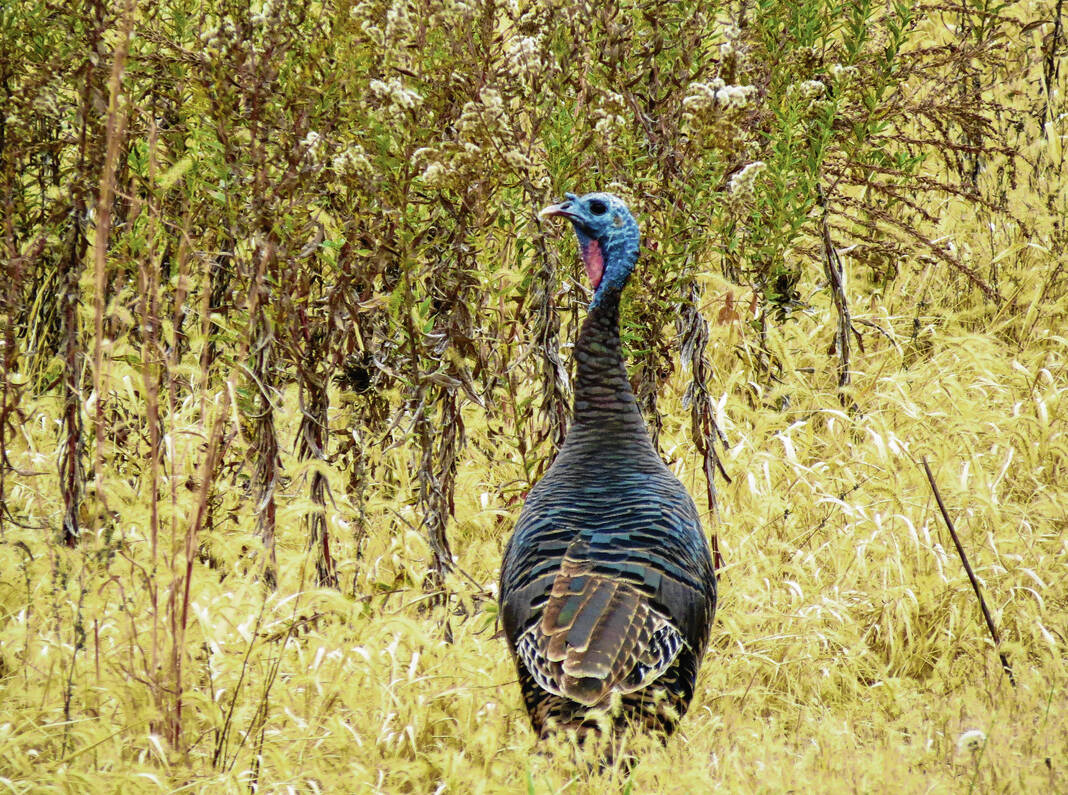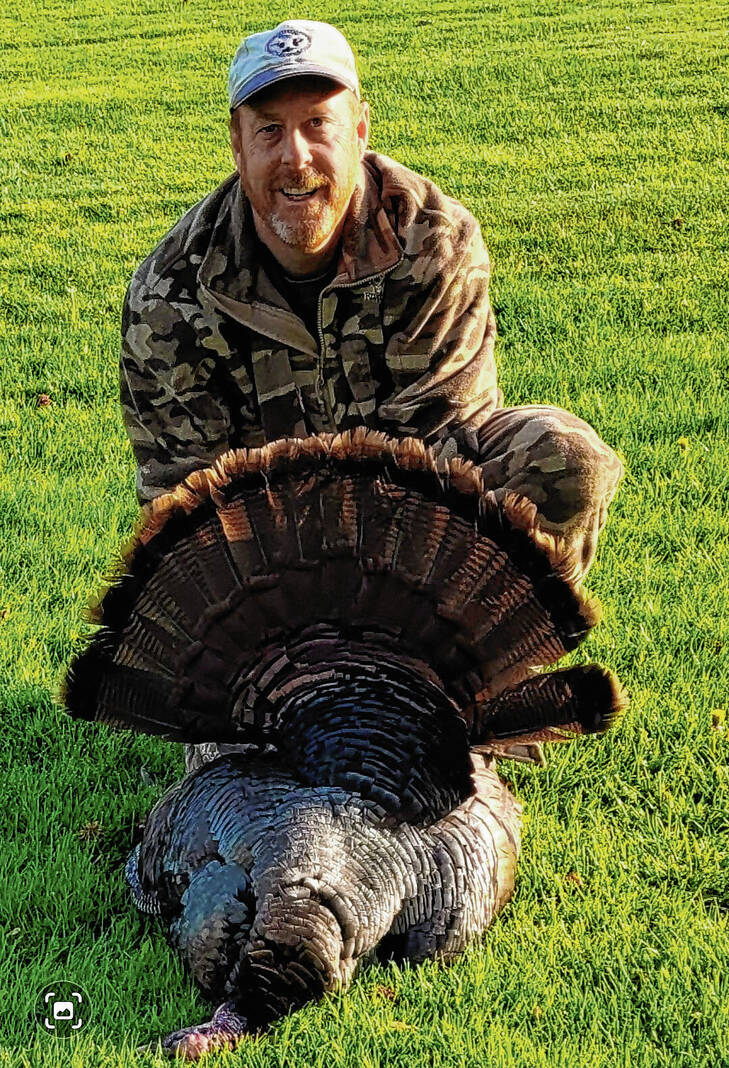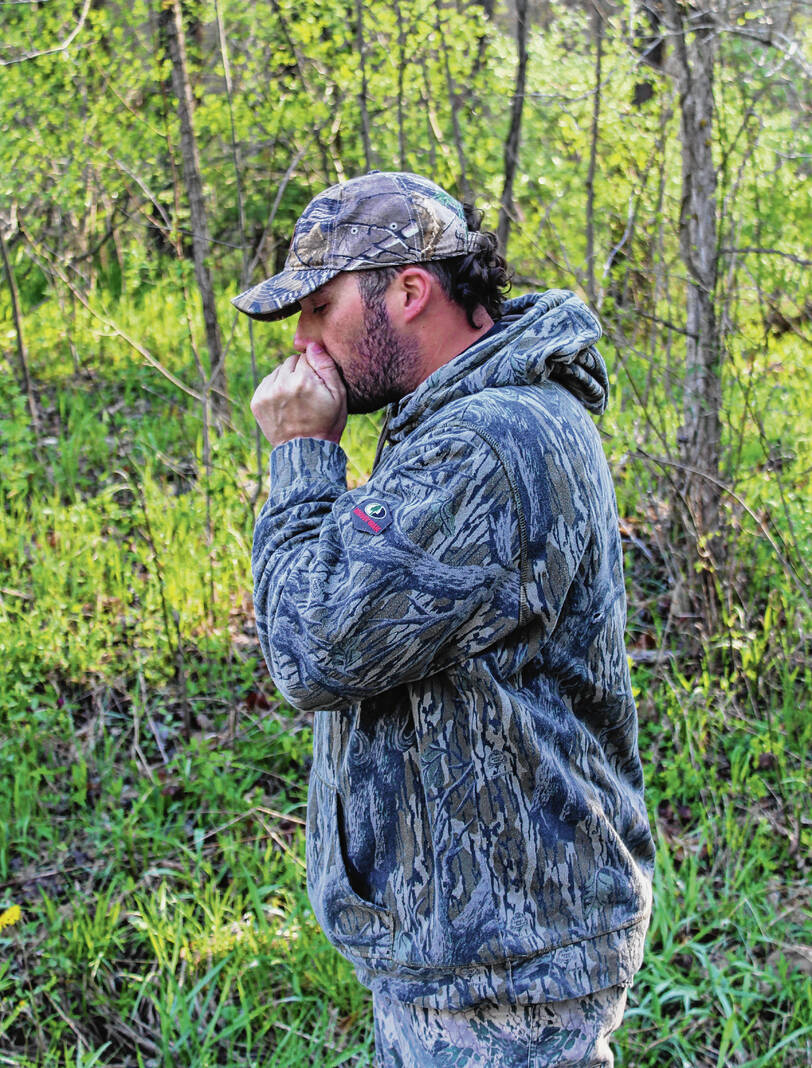
From the top: Turkeys like this one roam the grounds at Muscatatuck National Wildlife Refuge but are not always easy for hunters to shoot. // Seymour hunter Kevin McDonald bagged this 21-pound turkey on the second day of the state’s spring hunting season in Greene County. Courtesy U.S. Fish and Wildlife Service
Courtesy U.S. Fish and Wildlife Service

Seymour hunter Kevin McDonald bagged this 21-pound turkey on the second day of the state’s spring hunting season in Greene County.
Submitted photo

Lew Freedman | The Tribune
Bailey Julian of North Vernon kept calling turkeys on the first day of the spring season at Muscatatuck National Wildlife Refuge in Seymour, but none responded.
Lew Freedman | The Tribune
By Lew Freedman | The Tribune
Turkey hunting is about whistling in the dark, one might say, or the early stages of light on a crisp morning, a human hunter trying to trick a turkey to come into range to become his dinner.
It really is about talking turkey. Not in the vernacular phrase of getting down to business and dealing with substance. At least not precisely.
Only if the birds don’t listen, and the birds don’t respond, they do not come close enough to become targets. That was Bailey Julian’s issue last Wednesday at Muscatatuck National Wildlife Refuge on the first day of Indiana’s spring turkey hunting season.
He placed his call to his voice, made the appropriate noises and nada. No Tom would approach. There was little evidence a Tom was in the neighborhood, although there is ample evidence turkeys do hang out in the refuge’s 7,880 acres.
They can’t read the regulations that made them fair game, starting April 27 and running to May 15, but they did behave as if they were so informed and kept hidden.
Julian, 25, of North Vernon said he always sees turkeys moving about during fall deer hunting when he visits Muscatatuck, but not when he needed them.
“I didn’t even hear any,” he said.
Although Julian was one of 34 hunters who drew permits for opening day (which extended into the second day, too), the refuge was not densely populated with people. There were only a half-dozen or so trucks at parking pullouts or lots, and few hunters were visible stalking the turkeys. It did not seem as if many of the solo hunters (the permit is only good for one) chose to skip work after they signed up.
Julian woke at about 4:15 a.m. and reached Muscatatuck’s gate at around 5 a.m., where there wasn’t much of an automobile line waiting for the gate to open waiting for shooting time of a half-hour before sunrise.
The day did warm up and grow sunny, but at 8 a.m., the temperature was still just 38 degrees.
“I wondered if they weren’t moving around because it was cold,” Julian said.
There was a youth hunt the prior week at Muscatatuck, and the regular opening was on a mid-week day. The way the Muscatatuck season works, the state Department of Natural Resources handles the permit draw for the park, and that gives hunters chances to appear for the first six days of the season.
“After that, anyone can go hunting,” Muscatatuck Park Ranger Donna Stanley said.
Stanley said Muscatatuck does not have any sort of check-in procedure onsite for successful hunters to report their kills, but it is not renowned as a hunters’ turkey paradise.
“It’s a very low harvest rate,” she said. “On a good day, they might get two or three. They just don’t get them. There are lots of turkeys. They’re just elusive.”
Julian may be a longtime deer hunter, but he is still feeling his way around turkey hunting. This was just his second season giving it a try and figuring out the best places to find them and methods to hunt them.
“I recently got into it,” he said. “I like the sound of them when they’re gobbling. You basically have to reverse nature.”
It was an intriguing viewpoint. What Julian meant was that a hunter had to play the part of a hen luring a Tom in.
“You’re trying to get it to come to you,” Julian said.
It was pleasant enough to be in the woods on a dry day. Decked out in his camouflage, Julian listened to geese chirping away and could think about a turkey recipe he had for smoking the breast and basting it in honey — if he only had a turkey to cook.
Not that he was giving up. Julian planned to return the next day.
The second day of the hunt worked out much better for Kevin McDonald, a Seymour hunter who left town for his pursuit of the birds rather than compete for a Muscatatuck permit. McDonald’s family owns land in Jasonville in Greene County, 90-plus miles away, and he made his annual pilgrimage there.
McDonald, 56, is another longtime deer hunter who drifted into turkey hunter for the challenge. This was his sixth season. He went three strikes and out as a beginner but now has bagged a turkey the last three years in a row. He is one of the minority of turkey hunters who even tried a tree stand perch a couple of years ago, and it worked well.
This season, McDonald went out on opening day and called. There were Toms, but they were otherwise already occupied with girlfriends.
“I saw turkeys but couldn’t get any turkeys to respond,” he said. “They were with hens.”
He heard turkeys as early as 6:15 a.m., and he saw several Wednesday afternoon, so the next day, he went out earlier to a different spot and set up shop.
“I was in the woods at 5:30,” McDonald said. “I could get them to gobble, but I couldn’t get them to come in.”
He was well hidden in some woods, but his act didn’t fool any birds. After two hours, he shifted locales and began calling again. This time, a turkey called back. Once, twice, three times, McDonald called from the woods and the turkey gobbled.
“He came right in to about 10 yards,” he said. “He was right on top of me. He came to me so fast.”
McDonald raised his shotgun and fired. He scored, killing a bird weighing about 21 pounds with a 10-inch beard.
While some hunters are only after big birds, McDonald is happy to get one at all. This makes him three-for-three over recent years.
“I’m not real particular,” McDonald said. “I’m still a novice. If it’s a Tom and of decent size, it’s game on.”
The first one he killed, he had mounted, emblematic of success in his new sport. Last year, the bird was served up for meals.
“I don’t find them gamey,” he said of the taste.
The time he employed the same tree stand he had previously used for deer hunting, McDonald said the turkeys approached beneath him and never looked up.
“It works,” he said. “Guys have always said turkeys are more fun than deer.”
